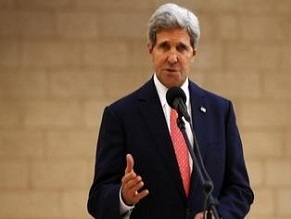|
World Jewish News

John Kerry Photo: Reuters
|
At halftime in peace talks, US mulls moving the goal posts
03.01.2014, Israel According to his aides, US Secretary of State John Kerry had to be restrained from flying to Jerusalem over the Christmas holiday to continue negotiations between Israel and the Palestinians.
Kerry wants a framework agreement between the parties sooner rather than later – preferably before April, when a commitment made by Prime Minister Binyamin Netanyahu and President Mahmoud Abbas to negotiate in earnest will expire.
“He has a real sense of urgency, a real sense of need to strike while the iron is hot,” one senior US administration official told reporters on New Year’s Eve. “We consider the iron to be hot.”
One thing is clear to all parties involved in the talks: The moment is certainly heated, be it by hot air or heightened tensions, by a fear of consequential failure or of the knowledge that, halfway through the nine-month negotiations timeframe, the parties are no closer to an agreement than they were last summer.
Announcing the peace talks from the State Department last July, Kerry warned that journalists reporting on the negotiations would publish largely inaccurate stories.
Nobody directly involved would be discussing the talks in public, he asserted.
That was true for several months, but it is no longer the case: After 20 official rounds of diplomacy, Saeb Erekat, the chief negotiator for the Palestinians, has repeatedly expressed doubts in public that the talks will succeed – certainly if the measure of success is a peace treaty between the Jewish State of Israel and an official State of Palestine.
“He has a real sense of urgency, a real sense of need to strike while the iron is hot,” one senior US administration official told reporters on New Year’s Eve. “We consider the iron to be hot.”
One thing is clear to all parties involved in the talks: The moment is certainly heated, be it by hot air or heightened tensions, by a fear of consequential failure or of the knowledge that, halfway through the nine-month negotiations timeframe, the parties are no closer to an agreement than they were last summer.
Announcing the peace talks from the State Department last July, Kerry warned that journalists reporting on the negotiations would publish largely inaccurate stories.
Nobody directly involved would be discussing the talks in public, he asserted.
That was true for several months, but it is no longer the case: After 20 official rounds of diplomacy, Saeb Erekat, the chief negotiator for the Palestinians, has repeatedly expressed doubts in public that the talks will succeed – certainly if the measure of success is a peace treaty between the Jewish State of Israel and an official State of Palestine.
That’s why senior US officials are now explaining the administration’s position to journalists. For months, officials from the White House and State Department insisted that they were not working toward an interim agreement – that they wanted a final-status accord addressing all outstanding issues, and nothing less. But the framework now being discussed allows the US to declare a victory with the conflict unresolved; it provides the parties with a way out of the nine-month timeframe, set in the first place to apply the pressure required on leadership to make tough political choices.
“This is not an effort to achieve an interim agreement. It is an effort to provide agreed guidelines for a permanent-status agreement – that is to say, a full and final peace treaty between the parties,” the senior administration official added. “Once they have a shared vision of what that will look like, then it will become easier to finalize the details, and there will be a lot of details in the actual permanent- status agreement itself.”
Just because nine months will likely pass without a final-status agreement, does not mean a framework agreement will be fruitless; it may extend the deadline, but may also bind Netanyahu and Abbas on a trajectory toward peace.
And yet the risks are real in moving the goal posts, and in allowing the negotiations to become a two-step process.
The administration argued for months that privacy was required during negotiations so that Netanyahu and Abbas could have generous time and space to weigh political sacrifices.
But once a framework agreement is announced, that will no longer apply; the space between that step and a final peace treaty will likely be dominated by critics of the two-state solution, now armed with specific policies built into the framework they will be keen to attack.
The administration hopes that, similar to the first-step deal forged in Geneva over Iran’s nuclear program, a framework that offers real prospects for peace will tempt the skeptics and the hopefuls.
They hope to earn themselves the benefit of the doubt. And perhaps with that, they will buy the time required to forge a final deal, with statehood and recognition and all.
By MICHAEL WILNER, JERUSALEM POST CORRESPONDENT
JPost.com
|
|
